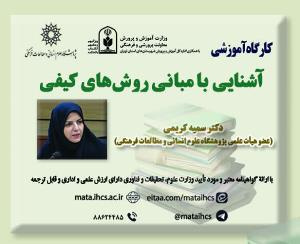تبیین و مقایسه سیمای پیامبر اکرم (ص) در دو متن عرفانی کشف المحجوب و مرصادالعباد (مقاله علمی وزارت علوم)
درجه علمی: نشریه علمی (وزارت علوم)
آرشیو
چکیده
شخصیت والا و سیره انسانی و نبوی پیامبر اکرم)ص( همواره از کانون های مضمون آفرینی و تصویرسازی شاعران و نویسندگان در ادب فارسی بوده است. عرفای فارسی گوی پس از اسلام تاکنون به مناسبت های گوناگون به تکریم آن حضرت پرداخته اند؛ به ویژه در ابتدای سخن خود پس از حمد و ستایش خالق هستی بخش، به بزرگداشت و مدح پیامبر، مقام نبوت و مخصوصاً خاتمیت و سرآمدی و محوریت وجود آن حضرت در کل کائنات توجه داشته اند. در این مقاله تلاش شده تا به شیوه توصیفی-تحلیلی سیمای حضرت رسول (ص) در دو کتاب مرصادالعباد و کشف المحجوب که خود از امهات متون گران سنگ ادبیات فارسی می باشند مورد بررسی و مقایسه قرارگیرد. هدف این جستار مقایسه کیفیت تبیین سیمای پیامبر(ص) در دو اثر مذکور است. در این راستا نشان دادن برتری های پیامبر اکرم ، ضرورت معرفت بیشتر آن حضرت و بیان خاتم بودن و منسوخ کردن ادیان دیگر توسط پیامبر(ص) قابل بیان می باشد. بدین منظور مباحثی چون مقایسه پیامبر اکرم با پیامبران دیگر مانند حضرت موسی، ابراهیم و ...، شریعت پیامبر به ویژه مقیّد بودن مؤلّف هر دو کتاب به آن و علل فرستادن شریعت پیامبر و جنبه های دیگری از ابعاد شخصیتی و تاریخی آن حضرت همچون واسطه آفرینش بودن، معراج، سایه نداشتن پیامبر و ... از منظر نجم دایه و هجویری مطمح نظر بوده است. نتایج پژوهش نشان از جایگاه خاص پیامبر و شریعت وی در سلوک عرفانی هر دو عارف دارد.Explaining and Comparing the Image of the Holy Prophet (PBUH) in Two Mystical Texts of Kashf al-Mahjoub and Mersad al-Ebaad
The sublime personality and prophetic character of the Holy Prophet (PBUH) has always been one of the centers of thematic creation and illustration of poets and writers in Persian literature. Especially at the beginning of their speech, after praising the Creator, they paid attention to the glorification of the Prophet, the position of Prophethood, and especially the finality and centrality of his existence in the whole universe. The descriptive-analytical method of the image of the Prophet (PBUH) in the two books of Mersad al-Ebaad and Kashf al-Mahjoub, which are among the most important texts in Persian literature, should be examined and compared. In this regard, showing the superiority of the Great Prophet, the need for more knowledge of that Imam and the expression of the Khaatam and the obsolescence of other religions by the Prophet (PBUH) can be expressed. Like Moses, Abraham, etc., the law of the Prophet, especially the fact that the author of both books is bound to it and the reasons for sending the law of the Prophet and other aspects of its dimensions Characteristic and historical aspects of that Imam, such as being the mediator of creation, ascension, not having a shadow of the Prophet, etc., have been considered from the perspective of Najm Dayah and Hujviri. The results of the research show the special position of the Prophet and his Shari'a in the mystical behavior of both mystics.







